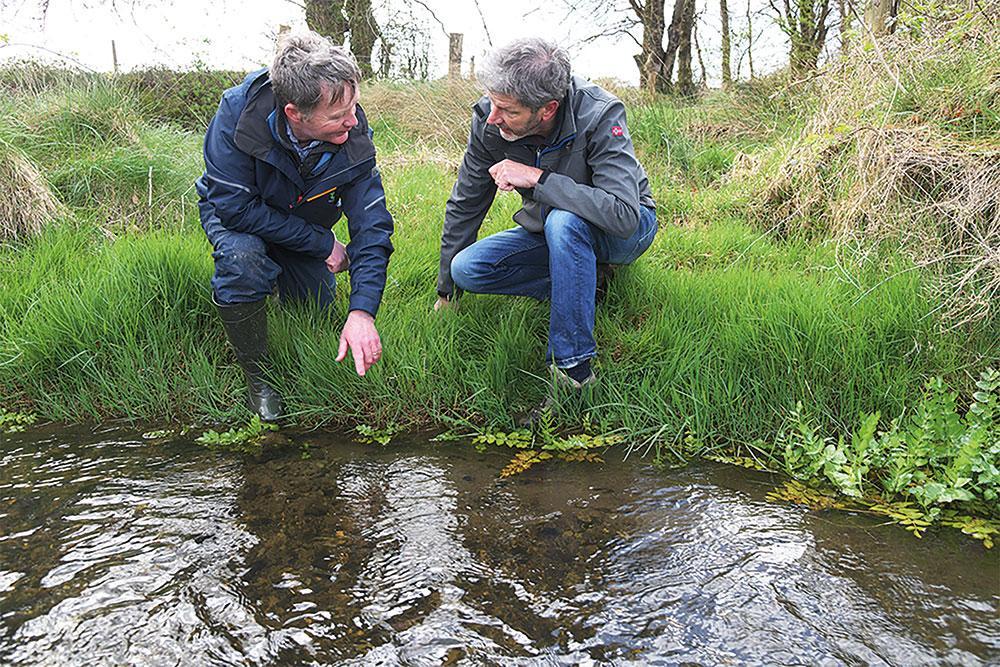20 August 2024
Easing the pressure
The Better Farming for Water campaign will be crucial to meeting objectives under the Water Framework Directive, explain Teagasc’s Director of Research, Pat Dillon, and Head of Environment Knowledge Transfer, Pat Murphy.
The Better Farming for Water campaign will be crucial to meeting objectives under the Water Framework Directive, explain Teagasc’s Director of Research, Pat Dillon, and Head of Environment Knowledge Transfer, Pat Murphy.

Mullingar-based Teagasc ASSAP advisor David Webster and farmer Shane Pearson examine Dysart stream at Clontineen, county Westmeath. Photo credit: Mark Moore
Clean water is a critical part of nature and human wellbeing. It is also a crucial resource for many economic sectors; agriculture needs a constant supply of fresh, clean water for animals, crops and food processing. Although water quality in Ireland compares favourably to the EU average, the challenge remains: meeting the objectives under the Water Framework Directive, whereby all waterbodies achieve good status by 2027.
The latest EPA Water Quality report, covering the period 2016–2021, found that 54% of our surface water had satisfactory (≥ good) ecological status. Overall water quality has not improved in recent years; the proportion of waterbodies improving in status has been exactly matched by that of those declining in status. The main causes of poor water quality are run-off of nutrients, sediment and pesticides from agricultural lands and farmyards; discharges of poorly treated sewage from urban wastewater treatment plants, domestic treatment systems and storm water overflows; hydromorphology; and run-off nutrients and sediment from forestry operations.
The Nitrate Directive, in place since 1991, aims to protect surface water from pollution by agriculture sources and promote good farming practices. The current Nitrate Action Programme, covering the period up to 31 December 2025, contains specific measures to protect surface waters from nutrient pollution arising from agriculture. Ireland has availed of a derogation from the maximum limit of 170 kg/ha of livestock manure nitrogen as provided in the Nitrate Directive. Maintaining Ireland’s nitrates derogation will require improvements in water quality.
In 2024, the Minister for Agriculture, Food and the Marine, Charlie McConalogue TD, requested Teagasc to lead a multi-actor water quality advisory campaign. The aim is to deliver clear, simple and positive messaging to enhance understanding – on farms and across the agri-food industry – of agriculture’s pressure on water quality and the need for improvement.
In response, Teagasc has developed the Better Farming for Water campaign, the objective of which is to reduce nutrient, sediment, pesticides and pathogen loss to all waterbodies. The campaign has identified 8-Actions for Change that farmers can make on-farm to improve water quality. These actions cover three critical management areas (nutrient, farmyard and land management) and apply to all farmers (dairy, dry stock and tillage).
The campaign will be delivered at farm, catchment and regional scale, and will be part of a wider whole-government approach to improve water quality.
Better Farming for Water – 8-Actions for Change will build on the progress made through existing water quality programmes such ASSAP, Farming for Water EIP, Waters of LIFE and Blue Dot Catchments. The campaign will be delivered by way of six pillars:
- Stakeholder engagement through a multi-actor approach (farmers, farming organisations, government departments, meat and milk processors, environmental regulators, media and local communities)
- Building awareness by acquisition and utilisation of water quality data
- Upskilling farmers, advisors, and industry professionals
- An impactful knowledge transfer programme
- Supporting research programme
- A strong communications plan
Find out more about the Better Farming for Water – 8-Actions for Change campaign at the link below: Better farming for water
